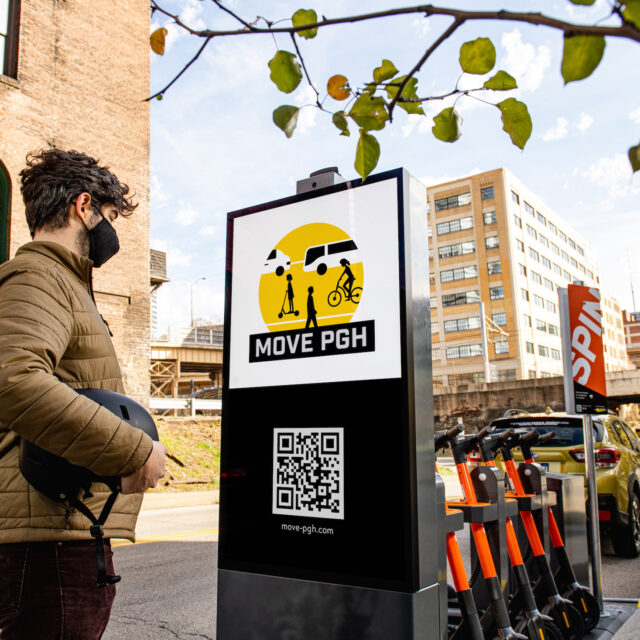Electrification in Shared Micromobility and Beyond
by Destinie Hammond, NABSA communications manager
June 30, 2022
Building the EV charging networks of tomorrow requires shared micromobility’s inclusion today.

The popularity of e-assist shared micromobility has grown exponentially since its start in 2018, as cities of all sizes take advantage of its ease, accessibility, and ability to help respond to climate change in the face of a dire need to lower global transportation-related emissions. To mitigate the worst effects of climate change, global leaders are prioritizing the electrification of transportation and incorporating electric vehicles (EV) and electric vehicle charging into transportation networks. As we seek to electrify transportation in these ways, shared micromobility – e-bikes and e-scooters – must also be included. Integrating shared micromobility into curbside electrical projects and EV charging networks will help build a multi-modal transportation ecosystem that provides viable alternatives to private car trips, while improving transportation equity and access.
Millions of people in North America rely on e-bikes and e-scooters to connect them to transit, essential services, and destinations that would otherwise be too far or cumbersome for walking or classic pedal bikes. The popularity and growth of ridership speak for themselves. For example, the 2020 NABSA Shared Micromobility State of the Industry Report found that more than 40 million trips were taken on e-bikes and e-scooters that year and they accounted for more than half of the 169,000 total vehicles deployed across North America. Additionally, e-bikes thrived in 2020 despite the COVID-19 pandemic. Ten million trips were taken on e-bikes, up from 7 million in 2019, and the percentage of systems that had e-bikes increased from 28% in 2019 to 44% in 2020. The average e-bike trip distance of two miles is nearly twice the average distance for pedal bikes. (Stay tuned for new 2021 statistics that will be released in our 2021 Shared Micromobility State of the Industry Report later this summer.)
These increased trip lengths that electric shared micromobility provides mean that users have increased access to destinations they might not have had before, or with more ease. In many cases, these trips replace a car trip or create a new connection to transit, making multi-modal mobility more accessible.
In these ways, shared micromobility also benefits cities and communities as a tool to achieve climate, sustainability, and equity goals. The availability of e-bikes and e-scooters encourages mode shift, the swapping of one mode of transportation for another. In this case, shared micromobility helps people replace short car trips with more sustainable options like biking, scooting, and transit. This mode shift is more important now as research continues to identify it as one of the most critical elements of climate change mitigation strategies. In 2020, 36% of shared micromobility trips replaced car trips, offsetting approximately 29 million pounds of carbon dioxide emissions. Additionally, shared micromobility helped users to replace short car trips with public transportation. In 2020, 50% of shared micromobility riders reported that they use shared micromobility to connect to transit, and 16% of all trips taken that year were for the purpose of connecting to transit. There are also economic benefits. An Emory University study found that e-scooter programs led to a 4.4% increase in unplanned restaurant spending per year.
To scale the above benefits and support the growing demand, developing connections to the electrical grid and implementing electric shared micromobility charging stations is essential. Charging for e-assist shared micromobility improves system efficiency by maintaining vehicle availability and reducing the need for battery swapping, which is time-intensive and involves travel.
“The shared micromobility industry is expanding rapidly and becoming an important component of a city’s overall transit network. With how quickly this mobility option is growing, charging infrastructure offers an important resource for micromobility providers by increasing the efficiency of local operations staff while helping provide a more reliable service to riders,” said Kyle Rowe, VP of Partnerships and Policy at Spin.
Charging stations provide users with a safe place to lock their shared micromobility vehicles, help maintain vehicle availability, and lower the need for operators to swap batteries. In May of this year, Chicago’s Divvy bike share system, operated by Lyft, became the first US city to incorporate e-bike charging stations into its network. The City of Chicago stated that this project allows them to continue to invest in low carbon mobility and provide residents with more ways to navigate the city without a car.
“With these new stations, our operator Lyft expects Divvy e-bikes will be charged using fewer van trips to swap batteries – reducing vehicle miles traveled (VMT) and cutting the carbon emissions associated with operating the system,” said Sean Wiedel, the Chicago Department of Transportation’s (CDOT) assistant commissioner of its Citywide Services Division.
By electrifying the curb and providing grid access for future shared micromobility charging stations, cities can lay the groundwork for expansion, extend the benefits of electric mobility, and build a more sustainable transportation ecosystem. Widespread electrification of the curb can simplify the installation of future charging infrastructure and provide a path for seamless expansion of charging networks.
One great example of this is the City of Vancouver’s Curbside Electrical Program. This program is part of Vancouver’s Climate Emergency Action Plan (CEAP) and provides grid access to EV charging stations, including its Mobi by Shaw Go bike share system, as part of their effort to have at least two-thirds of all trips completed on a bike, foot, or public transportation. To support this goal, Mobi by Shaw Go expanded by adding 50 e-stations and 500 e-bikes to the service area. By taking the initial step of electrifying the curb, Vancouver has put itself in an ideal place for the expansion of its bike share system.
“Bikeshare is one of the key axioms in Vancouver’s strategy to reach its mode share goals of two-thirds of all trips being done by active transportation and transit by 2030,” said Matej Mečár, policy analyst for the City of Vancouver. “An important step towards accomplishing this goal is the incorporation of e-bikes into the existing bike share network and connecting stations to the city’s curbside electrical grid.”
Co-locating electric shared micromobility charging facilities with transit and other modes helps integrate different service options, allowing users to move from one to the other for what fits their travel needs the most. For example, as part of the MovePGH initiative in Pittsburgh, PA, fifty mobility hubs equipped with shared micromobility charging stations will be available throughout the city near transit stops and POGOH bike share stations. According to David White, Executive Director of POGOH, cities will thrive when e-bikes are integrated into electric mobility planning.
“We worked with our city government and utility provider to co-locate scooter and bike share stations at transit stops and connect them to municipal streetlight infrastructure to power the stations and charge the bikes and scooters,” said David White. “The operational impacts of station charging are impressive. For POGOH, charging at just 50% of our bike share stations has virtually eliminated the need to swap batteries or move bicycles to a central location for charging.”
Initiatives to co-locate and integrate shared micromobility with transit and other mobility modes like MovePGH, and others in places like Austin, Las Vegas, and Detroit, bring us closer to building multi-modal transportation networks. Coupling this with electrifying the curb and installing electric shared micromobility charging can also help us meet mode shift and decarbonization goals, but only if they’re joined by safe places to ride to and from these locations, like protected bike lanes.
Safe, connected places to ride are a key component of the shared micromobility electrification equation. To support the user demand for electric shared micromobility and scale mode shift, people need safe, continuous places to ride that also bring them to meaningful destinations. There is still not nearly enough of this critical infrastructure. In the US, the National Highway Traffic Safety Administration (NHTSA) estimated that 42,915 people died in motor vehicle traffic crashes last year, a 10.5% increase from 2020. This represents a 5% increase in cyclist deaths and a 13% increase in pedestrian deaths. Such increases during a pandemic when there were fewer people driving demonstrates the urgent need for safe streets for all modes. It’s proven that people are more likely to choose non-car options for certain trips when they feel safe doing so. Additionally, research has concluded that installing bike lanes, especially protected bike lanes, leads to fewer fatalities and better road-safety outcomes for cyclists, pedestrians, and motorists. Installing protected bike lanes in tandem with charging facilities, mobility hubs, and transit locations encourage mode shift towards more sustainable modes and builds a cohesive multi-modal ecosystem.
Now, as countries like the US and Canada develop and carry out programs to create charging networks for electric vehicles, it is time to plan and implement charging for electric shared micromobility. Some new federal funding can support this, but it must be leveraged for this purpose. Examples include the Carbon Reduction Program (CRP) in the US, which includes eligibility for shared micromobility projects, and Canada’s Active Transportation Fund, which includes eligibility for street infrastructure improvements that could include installing grid connections as part of a project, or fixed shared micromobility assets like charging stations. While the National Electric Vehicle Infrastructure (NEVI) Program in the US is focused on building a charging network for cars, it is an opportunity to build grid connection points for future shared micromobility charging stations, which can be installed at the same time. The Coalition Helping America Rebuild and Go Electric (CHARGE) provides further recommendations for how the implementation of the US Infrastructure Investment and Jobs Act (IIJA) can support electric shared micromobility. NABSA co-chairs the CHARGE micromobility working group that developed these recommendations and is actively working to have these recommendations enacted.
As research and user demand have shown us, electrifying personally-owned vehicles will not alone achieve the necessary carbon offset to mitigate the worst effects of global warming. The transition to electric cars is not only an opportunity for four-wheeled vehicles but is also an opportunity to develop the infrastructure to support electric bikes and scooters too. Let’s use it.
This post originally appeared on the NABSA website. Continue the discussion about electrification in shared micromobility at the 2022 NABSA Annual Conference being held this year in Guadalajara, Mexico. In addition to conversations about electrification, the conference will explore shared micromobility as a climate action tool, mobility data, equity, and all things shared micromobility.



